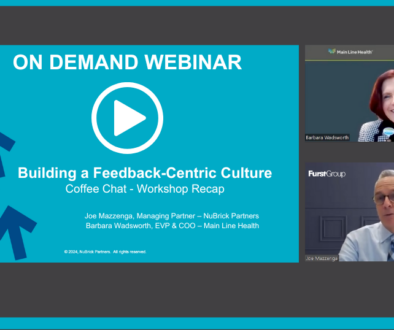Transforming Unconscious Bias into Conscious Inclusion | Webinar
Summary of unconscious bias webinar presented by Clarissa Peterson and Dave Appino of NuBrick Partners to the National Center for Healthcare Leadership
Unconscious bias is something we all have. Our body sends millions of bits of data to our brains every second to make sense of our environment, and our brains can only process a few dozen of them. As our brains quickly scan our surroundings for threats to our health, real or perceived, this can often generate biases that lead to errors in memory, judgment, and decisions without us being aware of it. But by being mindful and present, you can overcome these innate tendencies.
Practicing conscious inclusion helps leaders enhance psychological safety on their teams and develop an organizational culture that values diversity and inclusion. This is crucial to cultivating an environment where a true sense of belonging is possible for all team members.
In a recent webinar, Senior Consultant, Clarissa Peterson and Chief Operating Officer, Dave Appino discussed unconscious bias (what it is and why we all have it) and strategies you can use today (emotional intelligence and allyship) to create an inclusive culture on your team. Access the webinar or review the recap below.
Types of Unconscious Bias
Unconscious bias (also known as implicit bias) is a part of all of us and refers to assumptions we make about other people based on past experiences, attitudes, stereotypes, etc. As humans, our brain categorizes information to make sense of our world and help protect us from harm. These assumptions are deep-seated in our brains and are often connected to early life experiences.
Overall, there are more than one hundred types of unconscious bias. Some of the most common include:
- Affinity Bias – I like to hire people from my alma mater
- Ageism – This candidate is too old to bring the energy I need to this role
- Beauty Bias – This person doesn’t “look” the part
- Gender bias – They had a baby last year. They can’t handle a new promotion right now
- Halo/Horn – They will make a better employee because they went to an ivy league school
- Weight bias – A higher-weighted person will be undisciplined at work
Why Do We Have Unconscious Bias?
It starts in the brain. In their book, “Thinking, Fast and Slow,” world-renowned psychologist and Nobel Prize winner Daniel Kahneman explains the two systems that drive the way we think:
- System 1 – Intuitive. Unconscious and automatic
- System 2 – Slow. Logical. Deliberate. Requires intention
95% of our brain is System 1 – unconscious. This part of the brain is called the amygdala and activates our fight or flight reflex. The amygdala kept humanity alive in ancient times when we had no protection from flesh-eating creatures by helping us make quick, snap decisions and fight for our lives.
But the challenge with the amygdala is that it doesn’t know the difference between being chased by a tiger or being irritated by that colleague who sent you a snippy email on Thursday. It perceives both beings as a threat to your safety, and when we rely solely on our amygdala-derived unconscious bias to make judgments about other people, it becomes problematic.
In contrast, the other 5% of our brain, System 2, is in the prefrontal cortex. This is where thinking, logic, evaluation, what-to-do processing, and carefulness reside. When the prefrontal cortex is activated, you start to reach understanding and feel empathy. This intentional thinking is often referred to as mindfulness.
Ultimately, we need the amygdala to quickly process all the information we receive throughout the day and keep us from danger. However, activating our prefrontal cortex is equally critical so that we can be present and react to situations with mindful intention.
The Risks of Unconscious Bias
Unconscious bias negatively impacts organizational success and reduces diversity, equity, inclusion, and the employees’ overall sense of belonging. In fact, recent studies conclude that diversity is imperative for team culture and performance, citing that diverse teams are:
- 87% better at making decisions 1
- 35% more likely to outperform their competition 2
- 70% more likely to capture new markets 3
Diverse teams also
- Deliver increased performance by 56% 4
- Achieve higher revenues by 19% 5
- Have 50% less turnover 2
Beyond numbers, cultures centered on belonging increase psychological safety and overall team engagement and retention rates.
The key to creating and sustaining diverse teams is establishing a mindset of conscious inclusion to help leaders overcome innate and implicit bias at its root in the hiring process and beyond. Thankfully, there are practical steps you can take to overcome these limits and tap into mindfulness at any moment.
How to Overcome Unconscious Bias
Conscious inclusion is a practical approach to being more mindful of our biases, disrupting them, and driving thoughts, beliefs, and behaviors that value difference and diversity. To overcome unconscious bias, we must engage our prefrontal cortex using the following strategies:
1. Emotional Intelligence
2. Allyship
Emotional Intelligence
Emotional intelligence (EQ) is being aware of your emotions, noticing how your reactions to your emotions impact others, and using self-regulation to control your behavior or responses. EQ is a buildable skill that, if practiced intentionally, transforms the unconscious bias in our everyday lives.
To illustrate, imagine you are interviewing a candidate and suddenly realize this person looks like a previous boss with whom you did not get along. You immediately start feeling uncomfortable with the candidate. They are answering your questions flawlessly, but you have become disinterested.

Self-awareness is taking a mindful pause to notice the emotions you’re feeling and how those emotions are impacting your attitude and behavior toward this person. Has the individual done or said anything wrong? Being aware allows you to question your assumptions about people and recognize that your emotions are not always based on reality but on the category to which the brain has assigned someone.
Self-management is understanding and managing your behavior and reactions to your emotions and environment … particularly regulating responses to strong emotions like anger, embarrassment, frustration, or excitement. And when you react less desirably, own up to it, and apologize.
Social awareness is the ability to understand those around you and see things from their perspective. Perhaps the candidate is the best to fill the role, and their optimism is contagious. Social awareness gives you insight into their emotions, reactions, and behaviors acknowledging their inherent strengths.
Relationship Management is intentionally managing your interactions and relationships to optimize their effectiveness and create an atmosphere of psychological safety in your relationship.
Allyship
Allyship is a process of putting conscious inclusion into action.
- Make connections with people different from you based on trust, honesty, and learning
- Share what you’ve learned from their story. Look at the world through someone else’s eyes
- Use your privilege for good. We all have a privilege—financial, educational, health, etc.
- Help underrepresented groups intentionally with your privilege and access
- Hold yourself and others accountable for their actions by calling out inappropriate behavior
- Be curious and dig deeper. Get uncomfortable. Make mistakes. Apologize. Ask for help to understand what you don’t know. Learn.
Push past your biases and get outside of your comfort zone. Help your colleagues identify implicit biases and work to address them together.
By being present and mindful, you can practice conscious inclusion to successfully cultivate and strengthen relationships across your organizations and transform your workforce from the inside out.
Practicing Conscious Inclusion
During a recent presentation on Transforming Unconscious Bias into Conscious Inclusion, we handed out blue sheets of paper and asked the audience to engage in a commitment exercise around the question, “What one thing will you do to practice conscious inclusion?”
We barely got the question out before the audience exploded into collaborative conversations to brainstorm ideas. The response was overwhelmingly positive, with the audience returning more than 70 ideas on how they would practice conscious inclusion right away!
To say we were impressed is an understatement. What an inspiration to see a room full of leaders so energized and excited to make a real impact!
We have compiled their responses into eight categories and shared them in this Blue Notes report. As a music term in the Jazz or Blues genre, a Blue Note is a note that—for expressive purposes—is sung or played at a different pitch than the standard.
The ideas and concepts in this Blue Notes report represent a similar idea—moving away from an archaic, historically marginalizing pitch into a different sound. A new era of emotional intelligence where we lead from empathy and acceptance to build stronger, more diverse teams and organizational cultures that value curiosity and authenticity.
Together we can write a new melody, a beautiful symphony of voices and action that enables us to minimize our biases and drowns out systemic racism. A crescendo that carves a better path forward and reverberates into the future.
Thank you to everyone who participated in this commitment exercise and to all who read this report. Your commitment to diversity, equity, and inclusion is energizing, and we are excited to continue the conversation.
SOURCES
1 https://www.peoplemanagement.co.uk/article/1742040/diversity-drives-better-decisions
2 https://hbr.org/2013/12/how-diversity-can-drive-innovation
3 https://www.mckinsey.com/business-functions/people-and-organizational-performance/our-insights/why-diversity-matters
4 https://hbr.org/2019/12/the-value-of-belonging-at-work
5 https://www.bcg.com/en-us/publications/2018/how-diverse-leadership-teams-boost-innovation







